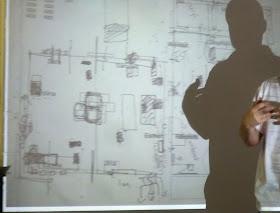On Tuesday we had a seminar. In the morning, professional practice - introduced by a quote from Grayson Perry: "Turn up on time, be nice, and work hard" - which says it all, really. The full presentation is at http://www.slideshare.net/l.bicknell/professional-practice-2012
 |
| Plans will need last-minute changes |
In the afternoon, a briefing on the final show (slideshowof the presentation is here and here). Certain deadlines were mentioned, and they seem very near and very final. Having been calmly and consistently working away on this'n'that, I have turned into a writhing mass of unresolved dilemmas. But the small still voice of reason is fighting its way through the tinnitus of panic, saying that there are Strategies that will help Overcome this Discombobulation (SOD).
SOD1 - sort out thoughts - write stuff down, preferably with a bowl of Belgian Chocolate with Salted Caramel and Roasted Hazelnut ice cream to hand
SOD2 - tidy up desk area, having set the timer for 15 minutes. Focus on the desk area. Try to find a place for things rather than dump them on another surface - label those places
SOD3 - set timer for 15 minutes (again and again) and look through shelves and boxes, sequentially around the room, for ALL the work made on the course - put it ALL in one place
SOD4 - in between the 15-minute sessions, do something distracting for a SHORT time (this may require setting the timer). Repeat 15-minute sessions as necessary
SOD5 - when all work is in one place, have another writing session, perhaps with a frappuccino-style iced coffee to hand (if not too late in the day)
SOD6 - make a nice long list of things to do, and guesstimate how long it will take to do each item
SOD7 - get blog up to date with college stuff and exhibitions - be brief and incisive (!)
SOD8 - remember "Rome wasn't built in a day" - the first of the deadlines is not tomorrow, or even next week (yet)
SOD9 - make a Studio Calendar on which to write deadlines, the three tasks for the day, AND things achieved each day
SOD10 - stop work at 7pm (it's so important to have a stopping time!)
There are other SOD options of course - and "your mileage may vary" ... but it's a starting point, it's a plan.
More plans and deadlines
Along with the planning of the final show (5-13 September, for your diary) is the planning of the show catalogue. The working group came up with this format -
Everyone is to produce 85 copies of their page by 29 June. The page can be made of whatever paper you choose (you're the one supplying it, after all) and can contain whatever you want - whew, too many decisions! The flap on the right will fold over and contain makers' info in a standardised form. The book will be 24cm square, joined with book screws.
Before that, the draft plan of our space in the show is due on 27 June. We went to look at the assigned room, and it looked kinda small for 20 people. Hopefully no-one will have a huge, dominant, central installation .. but anything could happen. Drafts change. The tutorials in mid-July will no doubt be dealing with issues arising, and last-minute panics.
Our written pieces about our work are due 6 August. The show starts going up on 14 August; the examiners do their work on 28-30 August; the private view is on 5 September.
First thing I'll do is make that Studio Calendar - various templates are available here.






























.jpg)


















